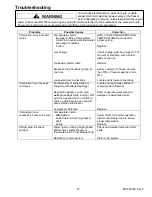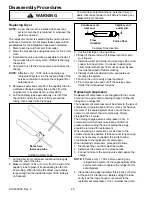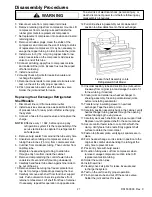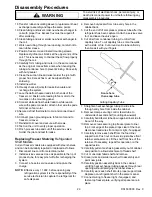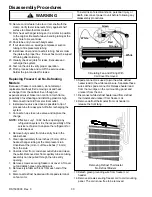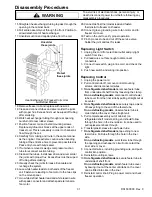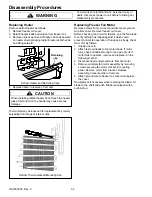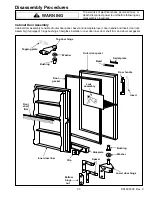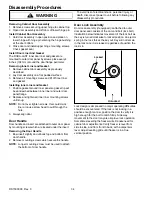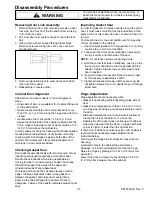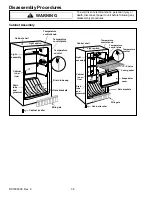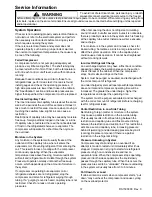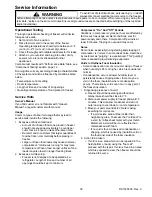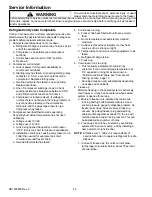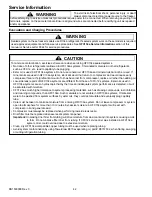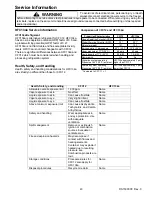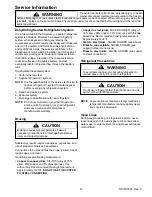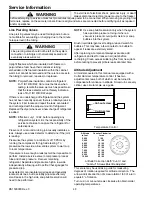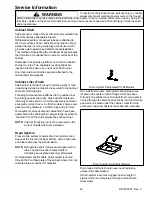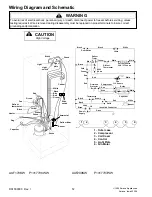
39
RS1500000 Rev. 0
Service Information
To avoid risk of electrical shock, personal injury, or death,
always disconnect electrical power source to the freezer
before attempting to service unless test procedures require power to be connected. When removing any wiring from
terminals, replace on the same terminals. Ensure all ground wires are connected before certifying unit as repaired
and/or operational.
WARNING
!
Operational Testing
Thorough operational checking of freezer will minimize
future service calls.
1. Set control to No. 4 position.
2. Place thermometer in the center of the freezer.
Operating temperatures should cycle b3°F
(cut in) to -2°F (cut out) in an empty cabinet.
3. Check thoroughly with reliable leak detector for leaks.
4. Attach a cycle recorder and plug into outlet. Verify
power source is not overloaded with other
appliances.
Compare test results with "Performance Data" table, see
"Component Testing" section, page 12.
Running time will vary according to design characteristics
of the system and will be influenced by conditions listed
below:
Temperature control setting
Room temperature
Length of time and number of lid openings
Quantity and temperature of food placed in freezer
Service Hints
Owner's Manual
If you find customer is not familiar with "Owner's
Manual", acquaint customer with manual.
Usage
Common types of abnormal usage that may lead to
service calls include the following:
1. Excessive unfrozen food load:
Amount of unfrozen food to be placed in freezer
should not exceed approximately 3 pounds per
cubic foot in 24 hours, unless otherwise noted.
Recommend to customer that larger quantities of
food be frozen commercially before placing in
freezer.
Larger unfrozen food loads may cause customer
complaints of "continuous running" or may raise
temperature of frozen food. Larger unfrozen food
loads may also result in longer freezing times.
2. Excessive Lid Opening:
Freezer is not designed to be operated as a
refrigerator. Length of time and number of lid
openings should be kept to minimum.
Compressor "On" And "Off" Periods
Variations in compressor cycles per hour are affected by
factors such as usage, ambient conditions, electric
power supply and others. Compressor off period is at
least 8 minutes. Tripping on overload may occur.
Noise
Some noise, especially during starting and stopping of
compressor, is normal. In some cases noise, described
by customer as "gurgling," is experienced. This "gurgling"
noise is caused by liquid entering evaporator.
Voids In Urethane Foam Insulation
Some condensation occurs on outer casing of freezer,
when humidity is 85% or higher, which is considered
normal.
If condensation occurs at lower humidity level or
persistently causes dripping water, there may be a
void in the foam insulation where condensation
occurs. Theoretically, voids can occur in any part of
the freezer insulation.
1. Diagnosing presence of a void:
a. Freezer should be operating and food-liner
temperature should be close to 0°F.
b. Disconnect power supply to freezer and wait 10
minutes. This will allow condenser and skin of
outer casing to cool down to room temperature.
c. Move your palm around skin of outer casing,
searching for cold spots.
If a void exists, area will feel colder than
neighboring area. To access that "cold spot" is
a void, try to flex sheet metal with your thumb.
Metal over a void will be more flexible than
metal backed with foam.
If no void is found, observed condensation or
dripping, which is caused by insulation void on
the food-liner side of the foam insulation.
2. Action to be taken:
If void is in an area which can be repaired in the
field (bottom or back) using the "foam kit",
proceed with the repair. If void is found in an area
which is exposed to view, then freezer should be
returned to source.

